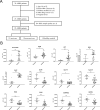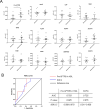Increased pro-SFTPB in HDL promotes the pro-inflammatory transition of HDL and represents a sign of poor prognosis in ARDS patients
- PMID: 39819672
- PMCID: PMC11740663
- DOI: 10.1186/s12967-025-06100-6
Increased pro-SFTPB in HDL promotes the pro-inflammatory transition of HDL and represents a sign of poor prognosis in ARDS patients
Abstract
Background: Acute respiratory distress syndrome (ARDS) is causatively associated with excessive alveolar inflammation involving deregulated pro-inflammatory macrophage polarization. High-density lipoprotein (HDL) showed critical anti-inflammatory roles by modulating macrophage function, and its adverse transition to pro-inflammation has an important role in the pathogenesis of ARDS. However, the relationship between HDL protein constituents and functional remodeling is unknown in ARDS.
Methods: Proteomic techniques were applied to examine the protein profile changes in HDL from septic-ARDS patients versus HDL from healthy controls across two distinct cohorts: a discovery cohort (8 patients and 8 healthy controls) and a validation cohort (22 patients and 10 healthy controls). The changed components significantly associated with prognosis were identified. Luminex assessed the levels of 38 plasma cytokines and chemokines. The in vitro constructed pro-SFTPB enriched HDL was applied to confirm the effect on M1 polarization of THP1-derived macrophage.
Results: 18 proteins were validated from 102 changed HDL proteins identified in the discovery cohort, including HDL particle components, such as apolipoproteins, pro-inflammatory substances known as serum amyloid As (SAAs), and anti-oxidative proteins like paraoxonases (PONs). Among these proteins, only the increase of pro-SFTPB in HDL was significantly associated with poor prognosis of ARDS patients. Notably, HDL-pro-SFTPB level was correlated with plasma pro-inflammatory cytokines and chemokines levels. The correlation assay of pro-SFTPB with other HDL components showed that it was positively and negatively correlated with SAA2 and PON3, respectively. Furthermore, the in vitro studies confirmed that the pro-SFTPB enriched HDL significantly promoted M1 polarization of monocyte-derived macrophages.
Conclusions: The increase of HDL-pro-SFTPB promotes HDL pro-inflammatory transition during septic ARDS, leading to exacerbated progression of ARDS through enhancing M1 macrophage polarization. HDL-pro-SFTPB could be a useful prognostic biomarker for septic ARDS.
Keywords: ARDS; HDL proteomics; Macrophage; Pro-SFTPB; Sepsis.
© 2025. The Author(s).
Conflict of interest statement
Declarations. Ethics approval and consent to participate: All studies involving human samples were approved by the Ethics Committee of Beijing Chao-Yang Hospital (2021-KE-313) and Beijing Youan Hospital (approval No.: LL-2021-148-K) and informed consent for research use of samples was obtained from all subjects. All methods were carried out in accordance with relevant guidelines and regulations, including the Code of Ethics of the World Medical Association (Declaration of Helsinki). Consent for publication: Not applicable. Competing interests: The authors declare that they are no conflicts of interest.
Figures






Similar articles
-
The HDL from septic-ARDS patients with composition changes exacerbates pulmonary endothelial dysfunction and acute lung injury induced by cecal ligation and puncture (CLP) in mice.Respir Res. 2020 Nov 4;21(1):293. doi: 10.1186/s12931-020-01553-3. Respir Res. 2020. PMID: 33148285 Free PMC article.
-
IFIH1/IRF1/STAT1 promotes sepsis associated inflammatory lung injury via activating macrophage M1 polarization.Int Immunopharmacol. 2023 Jan;114:109478. doi: 10.1016/j.intimp.2022.109478. Epub 2022 Nov 30. Int Immunopharmacol. 2023. PMID: 36462334 Free PMC article.
-
CD274 (PD-L1) negatively regulates M1 macrophage polarization in ALI/ARDS.Front Immunol. 2024 Feb 19;15:1344805. doi: 10.3389/fimmu.2024.1344805. eCollection 2024. Front Immunol. 2024. PMID: 38440722 Free PMC article.
-
The Role of M1/M2 Macrophage Polarization in Rheumatoid Arthritis Synovitis.Front Immunol. 2022 May 19;13:867260. doi: 10.3389/fimmu.2022.867260. eCollection 2022. Front Immunol. 2022. PMID: 35663975 Free PMC article. Review.
-
The Role of Macrophages and Alveolar Epithelial Cells in the Development of ARDS.Inflammation. 2023 Feb;46(1):47-55. doi: 10.1007/s10753-022-01726-w. Epub 2022 Sep 1. Inflammation. 2023. PMID: 36048270 Free PMC article. Review.
Cited by
-
Mass spectrometry-based quantification of proteins and post-translational modifications in dried blood: longitudinal sampling of patients with sepsis in Tanzania.bioRxiv [Preprint]. 2025 Apr 28:2025.04.22.650109. doi: 10.1101/2025.04.22.650109. bioRxiv. 2025. PMID: 40492198 Free PMC article. Preprint.
References
MeSH terms
Substances
LinkOut - more resources
Full Text Sources
Research Materials
Miscellaneous

